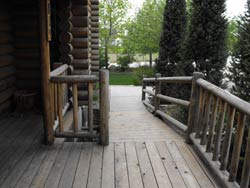 |
Ramp #11 (Great Ramp)
This is a well thought out ramp. Not only does it blend into the log cabin style architecture much thought was given to placement and safety to ensure the ramp did not look out of place in front of the home. Landscaping is well placed providing shade and camouflage without impeding traffic up and down the ramp. The ramp can be accessed directly from the driveway by a small, wide sidewalk and loading area. The ramp leads to a large covered porch providing excellent coverage and shelter during inclement weather. The only drawback with this ramp is the pitch does exceed the ADA recommendation but given the restraints caused by the location this is a very well thought out ramp.
|
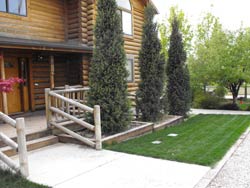 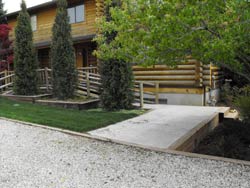 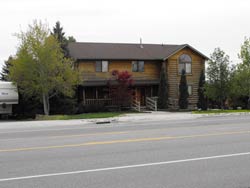 |
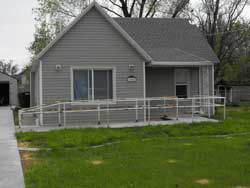
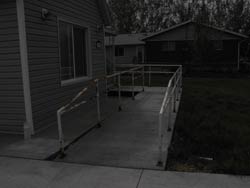 |
Ramp #12 (Great Ramp)
This ramp was built for a very small drop (6 inches) but every precaution has been taken for safety. This ramp is well over 5 feet wide and well over the ADA recommended 6 foot length with ample corner room. The ramp ends on the level with a wide driveway for loading and unloading ease and convenience. The landing at the front door is a covered porch with plenty of space to maneuver both the screen door and the main door. The home owner reports the only drawback with this ramp has been the paint used on the metal railings. These are scheduled for sandblasting and re-painting with the appropriate metal paint. As with all metal railings periodic maintenance will be required.
|
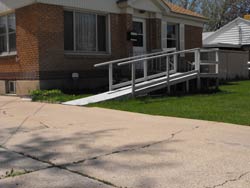
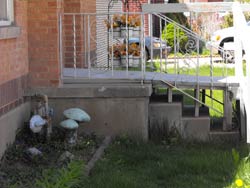 |
Ramp #13 (OK Temporary Ramp)
This ramp is an obvious addition to an older home. Designed for the short term this ramp has been built of plywood and raw 2"x4" materials. Wedge construction has been used on the surface of the porch to make the ramp surface even with the door threshold preventing an unsafe sudden drop of several inches (see second photo).
The ramp itself is narrow and has been propped up in several places along the center of the plywood flooring to prevent sag. Construction materials used are not meant for use in inclement weather creating the need for a sturdier replacement ramp in the near future.
|
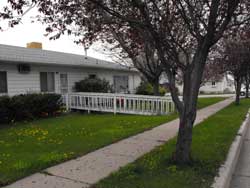 |
Ramp #14 (Another Straight Shot)
This ramp is yet another illustration of narrow, "Straight to the sidewalk" construction. There is a slight widening of the ramp at the doorway landing that gives little wiggle room for the user. Opening the screen door would be a challenge for most wheelchair occupants.
The end of the ramp, while ending at the sidewalk, is next to a grass covered park strip which would be difficult to maneuver over. Concreting this section of the park strip would allow easier access to a motor vehicle.
|
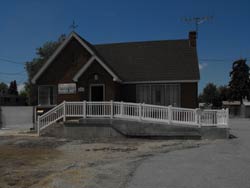
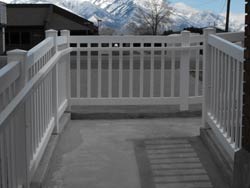 |
Ramp #15 (Excellent Ramp)
This ramp is an excellent example of a ramp retrofitted to an older existing home. While this home has been converted for business use the entry configuration for a private residence would remain the same. Covered parking is located at the rear of the building.
Note the edging treatment used by the contractor on the concrete. It is recommended a drain hole be placed at intersections and on flat landings to prevent pooling of water.
This ramp exceeds ADA in width and distance required.
|
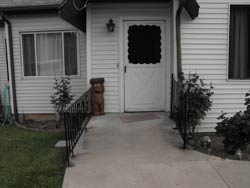
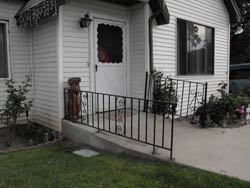 |
Ramp #16 (Excellent Direct Entry)
This entry is less a ramp and more a "sloped entry". Retrofitted some years ago by a previous home owner care was taken to ensure the slope of the concrete into the home was adequate with proper attention given to width and landing. The sidewalk was widened in two directions with direct access to both the street and the driveway for safe loading.
Care was also taken in grading the landscape to decrease danger of roll-offs and allow access to the yard.
|
 |
Ramp #17
This ramp is a prefabricated aluminum ramp that has been temporarily attached to the porch of this home. Because the porch is low to the ground this ramp meets ADA slope requirements without any further adaptations. The ramp attaches directly to the door threshold and anchored into the concrete. Double railings and a textured floor make this an excellent temporary ramp.
|
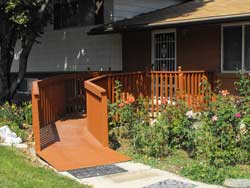 |
Ramp #18
This curved ramp is an excellent addition to this home. The builder followed the existing walkway keeping the flower beds intact. However, the slope is greater than the recommended 12:1 pitch and the walkway is a bit narrow. This ramp could have been extended two more feet without difficulty.
|
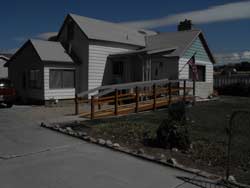 |
Ramp #19
Another ramp built to follow an existing walkway. Attached directly to the porch floor with a seamless transition this ramp does not encroach on the large porch itself. This leaves plenty of room for equipment and maneuvering through the doorway without difficulty. Large railings designed for direct hand grip allows individuals with limited balance to walk up or down the ramp with ease. This ramp leaves plenty of room to load at the driveway and is close to the recommended 12:1 pitch.
|
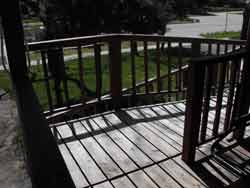 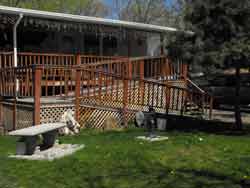 |
Ramp #20 Two-Story Residential Ramp
This two-story residential ramp is an SNRP favorite. The builder made full use of the available space in the front of the house and yard to add a fully covered porch and entry ramp to the front of this private home. Built of weathered redwood this ramp is sloped properly and long enough for the height of the porch at front door level (a 12:1 pitch), is wide enough to accommodate a full sized wheelchair with room to spare, and provides adequate stopping space at the switch back for a short breather if needed.
The only problem with this ramp is the wooden surface of the ramp does not end flush with the porch floor. A 2-inch wide gap exists which could catch narrow front casters in the resulting gap or be a trip hazard for those using a cane or otherwise walking up the ramp to the porch.
|
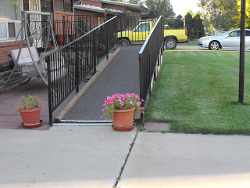 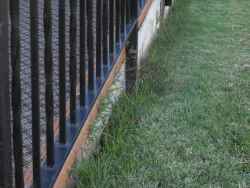 |
Ramp #21 Good Ramp
This ramp is an excellent design with some obvious thought going into it, pre-construction. While difficult to see from this angle, the landing at the doorway is flat, covered and close to the mandatory 5ft. square enabling the wheelchair user plenty of maneuvering room to open and close the front door. The downhill slope is close to the recommended 12:1 pitch
Note the railing attachments. Railing supports are attached to the outside edge of the ramp by large lag screws with bases concreted directly into the ground at the lower end. A 2"x4" sill plate runs the length of the ramp itself which allows the user to get close enough to the railing to grip and use as a support for pulling up and down without having to worry about small front casters rolling off under the lower bar of the railing.
The only disadvantage to this ramp is the sill plate at the bottom. It's not quite flush with the concrete and does create a small bump for the user. A fix has been requested by the owner with the contractor waiting for better weather before attempting any concrete work.
|



